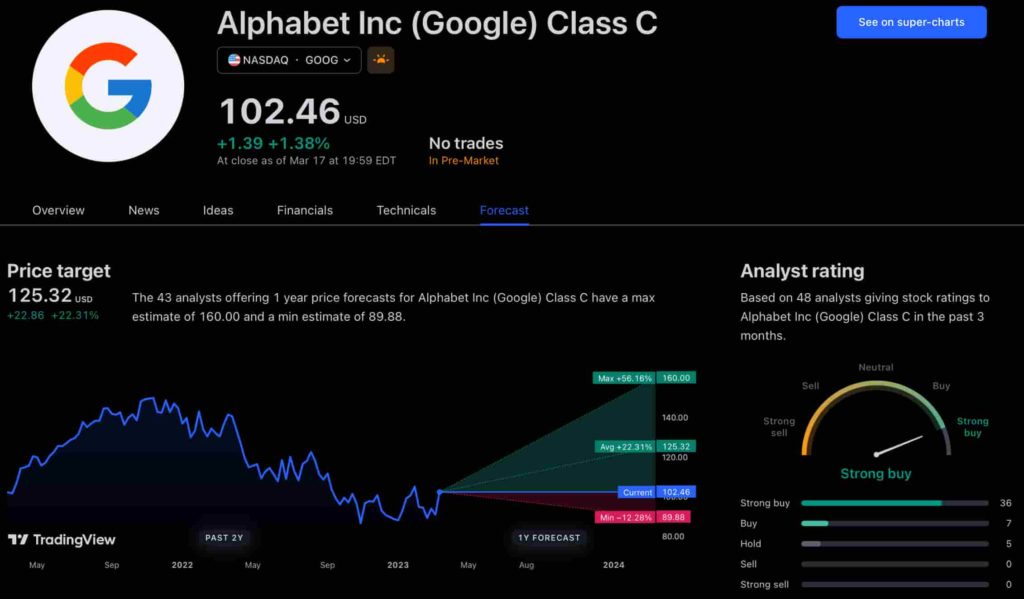The new app is called watchGPT and as I tipped off already, it gives you access to ChatGPT from your Apple Watch. Now the $10,000 question (or more accurately the $3.99 question, as that is the one-time cost of the app) is why having ChatGPT on your wrist is remotely necessary, so let’s dive into what exactly the app can do.
NEWS
Google on Penalizing Misinformation

A member of the SEO community expressed the opinion that misinformation in medical search results topics are as harmful and bad for users as spam content. And if that’s true, then why why doesn’t Google penalize misinformation sites with the vigor that Google penalizes sites for spam? Google’s Danny Sullivan offered an explanation.
Should Misleading Information Be Treated Like Spam?
Joe Hall (@joehall), a member of the search marketing community, framed the question of misinformation in the search results within the context of a bad user experience and compared it to spam.
One of the reasons why Google cracks down on spam is because it’s a poor user experience, so it’s not unreasonable to link misinformation with spam.
Joe Hall isn’t alone in linking misleading information with spam. Google does too.
Google Defines Misleading Content as Spam
Google’s own Webmaster Guidelines defines misleading information as spam because it harms the user experience.
“A rich result may be considered spam if it harms the user experience by highlighting falsified or misleading information. For example, a rich result promoting a travel package as an Event or displaying fabricated Reviews would be considered spam.”
If a user searches for “this” and is taken to a page of content about “that,” according to Google’s own guidelines, that’s considered spam.
Is Misleading Different From Misinformation?
Some may quibble that there’s a difference between the words misleading and misinformation.
But this is how the dictionary defines those words:
Merriam-Webster Definition of misleading:
“…to lead in a wrong direction or into a mistaken action or belief often by deliberate deceit… to lead astray : give a wrong impression…”
Merriam-Webster Definition of Misinformation:
“…incorrect or misleading information”
Regardless if you believe that there’s a gulf of difference between misleading and misinformation, the end result is the same, an unfulfilled user and a bad user experience.
Google’s Algorithm Designed to Fulfill Information Needs
Google’s documentation on their ranking updates states that the purpose of the changes is to fulfill users information needs. The reason they want to send users to sites that fulfill their information needs is because that’s a “great user experience.”
Here’s what Google said about their algorithms:
“The goal of many of our ranking changes is to help searchers find sites that provide a great user experience and fulfill their information needs.”
If a site that provides quality information provides a great user experience then it’s not unreasonable to say that sites that provide misleading information provide a poor user experience.
The word “egregious” means shockingly bad, an appropriate word to describe a site that provides misleading information for sensitive medical related search queries.
So, if it’s true that misleading information provides a poor user experience then why isn’t Google tackling these sites in the same way they take down spam sites?
If misleading information is as bad or worse than spam, why doesn’t Google hand out the most severest penalties (like manual actions) to sites that are egregious offenders?
“If you are found to spread misinformation about COVID19 vaccines… Then you shouldn’t be in Google’s index at all. It’s time that G puts it’s money where its mouth is in regards to content quality.”
Joe next tweeted about the seeming futility of the algorithm or concepts like E-A-T for dealing with misinformation and the difference between how Google treats spam and misinformation:
“Forget Core Quality Updates, YMYL, and EAT, just kick them out of the index. Sick of seeing Google put the hammer down for things like buying links… But consistently turns a blind eye to content that causes real harm to people.”
Google Responds to Issue of Misinformation in SERPs
Google’s Danny Sullivan insisted that Google is not turning a blind eye to misinformation. He affirmed Google’s commitment to showing useful information in the SERPs.
We don’t turn a blind eye. Just because something is indexed is entirely different from whether it ranks. We invest a huge amount of resources to ensure we’re returning useful, authoritative information in ranking. See also: https://t.co/SRUFrTcg56 and https://t.co/cTveD8XNxp
— Danny Sullivan (@dannysullivan) December 10, 2020
The end result is the same. Our systems look to reward quality. If you are posting misinformation, you’re not rewarded, because you don’t rank well. If you try to artificially boost your relevance, you’re not rewarded, because you get a manual action and don’t rank well.
— Danny Sullivan (@dannysullivan) December 10, 2020
“Bottom line, protecting your user’s life/health should take a higher precedence than punishing link buyers.”
“It already does. You are choosing to deliberately focus on the fact that we take manual action on *some* things in *addition to* automated protections to make it seem like our existing ranking systems are somehow not trying to show the best and most useful info we can.”
Google’s Danny Sullivan then followed up with:
“It seems like you equate manual action in the case of some spam attempts as somehow like we’re not working across all pages all the time to fight both spam and misinformation. We are.”
Joe Hall returned to ask why misleading sites aren’t penalized in a similar manner as spam is:
I understand that. The point I’m trying to make is why isn’t there a manual penalty for spreading disinformation that can kill people? Why is it that manual penalties are only reserved for links? Algorithms don’t carry the same message that manual penalties do.
— Joe Hall 🦡 (@joehall) December 11, 2020
Danny explained in two tweets the challenge of manually reviewing millions of misleading sites and of ranking breaking news:
“There are millions of pages with misinformation out there. We can’t manually review all existing pages, somehow judge them & also review every new page that’s created for topics that are entirely new. The best way to deal with that is how we do, a focus on quality ranking…
Remember the whole 15% of queries are new thing. That’s a big deal. Some new story breaks, uncertain info flows, misinfo flows along with authority info that flows. Our systems have to deal with this within seconds. Seconds. Over thousands+ pages that quickly emerge…”
Next Danny asserted that automated systems do far more heavy lifting against spam than manual actions.
“Yes, we will take manual actions in addition to the automated stuff, but that’s a tiny amount and also something where a manual approach can work, because it’s pretty clear to us what’s spam or not.”
Google and Misinformation
It’s uncertain whether Google’s algorithms are doing a good job surfacing high quality information in the search results.
But the question as to whether Google should elevate how it treats misinformation is a valid one. Particularly in YMYL queries in medical topics, blocking misinformation in those search results seems to be as important as blocking spam.
Facebook Faces Yet Another Outage: Platform Encounters Technical Issues Again

Uppdated: It seems that today’s issues with Facebook haven’t affected as many users as the last time. A smaller group of people appears to be impacted this time around, which is a relief compared to the larger incident before. Nevertheless, it’s still frustrating for those affected, and hopefully, the issues will be resolved soon by the Facebook team.
Facebook had another problem today (March 20, 2024). According to Downdetector, a website that shows when other websites are not working, many people had trouble using Facebook.
This isn’t the first time Facebook has had issues. Just a little while ago, there was another problem that stopped people from using the site. Today, when people tried to use Facebook, it didn’t work like it should. People couldn’t see their friends’ posts, and sometimes the website wouldn’t even load.
Downdetector, which watches out for problems on websites, showed that lots of people were having trouble with Facebook. People from all over the world said they couldn’t use the site, and they were not happy about it.
When websites like Facebook have problems, it affects a lot of people. It’s not just about not being able to see posts or chat with friends. It can also impact businesses that use Facebook to reach customers.
Since Facebook owns Messenger and Instagram, the problems with Facebook also meant that people had trouble using these apps. It made the situation even more frustrating for many users, who rely on these apps to stay connected with others.
During this recent problem, one thing is obvious: the internet is always changing, and even big websites like Facebook can have problems. While people wait for Facebook to fix the issue, it shows us how easily things online can go wrong. It’s a good reminder that we should have backup plans for staying connected online, just in case something like this happens again.
NEWS
We asked ChatGPT what will be Google (GOOG) stock price for 2030

Investors who have invested in Alphabet Inc. (NASDAQ: GOOG) stock have reaped significant benefits from the company’s robust financial performance over the last five years. Google’s dominance in the online advertising market has been a key driver of the company’s consistent revenue growth and impressive profit margins.
In addition, Google has expanded its operations into related fields such as cloud computing and artificial intelligence. These areas show great promise as future growth drivers, making them increasingly attractive to investors. Notably, Alphabet’s stock price has been rising due to investor interest in the company’s recent initiatives in the fast-developing field of artificial intelligence (AI), adding generative AI features to Gmail and Google Docs.
However, when it comes to predicting the future pricing of a corporation like Google, there are many factors to consider. With this in mind, Finbold turned to the artificial intelligence tool ChatGPT to suggest a likely pricing range for GOOG stock by 2030. Although the tool was unable to give a definitive price range, it did note the following:
“Over the long term, Google has a track record of strong financial performance and has shown an ability to adapt to changing market conditions. As such, it’s reasonable to expect that Google’s stock price may continue to appreciate over time.”
GOOG stock price prediction
While attempting to estimate the price range of future transactions, it is essential to consider a variety of measures in addition to the AI chat tool, which includes deep learning algorithms and stock market experts.
Finbold collected forecasts provided by CoinPriceForecast, a finance prediction tool that utilizes machine self-learning technology, to anticipate Google stock price by the end of 2030 to compare with ChatGPT’s projection.
According to the most recent long-term estimate, which Finbold obtained on March 20, the price of Google will rise beyond $200 in 2030 and touch $247 by the end of the year, which would indicate a 141% gain from today to the end of the year.
Google has been assigned a recommendation of ‘strong buy’ by the majority of analysts working on Wall Street for a more near-term time frame. Significantly, 36 analysts of the 48 have recommended a “strong buy,” while seven people have advocated a “buy.” The remaining five analysts had given a ‘hold’ rating.

The average price projection for Alphabet stock over the last three months has been $125.32; this objective represents a 22.31% upside from its current price. It’s interesting to note that the maximum price forecast for the next year is $160, representing a gain of 56.16% from the stock’s current price of $102.46.
While the outlook for Google stock may be positive, it’s important to keep in mind that some potential challenges and risks could impact its performance, including competition from ChatGPT itself, which could affect Google’s price.
Disclaimer: The content on this site should not be considered investment advice. Investing is speculative. When investing, your capital is at risk.
NEWS
This Apple Watch app brings ChatGPT to your wrist — here’s why you want it

ChatGPT feels like it is everywhere at the moment; the AI-powered tool is rapidly starting to feel like internet connected home devices where you are left wondering if your flower pot really needed Bluetooth. However, after hearing about a new Apple Watch app that brings ChatGPT to your favorite wrist computer, I’m actually convinced this one is worth checking out.
-

 SEARCHENGINES6 days ago
SEARCHENGINES6 days agoGoogle Core Update Volatility, Helpful Content Update Gone, Dangerous Google Search Results & Google Ads Confusion
-

 SEO6 days ago
SEO6 days ago10 Paid Search & PPC Planning Best Practices
-

 MARKETING7 days ago
MARKETING7 days ago2 Ways to Take Back the Power in Your Business: Part 2
-

 MARKETING5 days ago
MARKETING5 days ago5 Psychological Tactics to Write Better Emails
-

 SEARCHENGINES5 days ago
SEARCHENGINES5 days agoWeekend Google Core Ranking Volatility
-

 MARKETING6 days ago
MARKETING6 days agoThe power of program management in martech
-

 PPC7 days ago
PPC7 days agoCritical Display Error in Brand Safety Metrics On Twitter/X Corrected
-

 SEO5 days ago
SEO5 days agoWordPress Releases A Performance Plugin For “Near-Instant Load Times”













